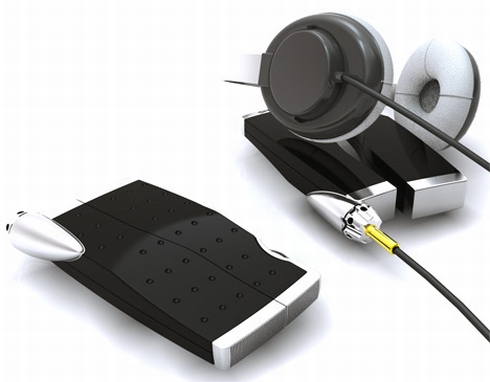No cellular phone features! Yes, you are right, the Nokia 770 is the first gadget released by Nokia which is not a cellular phone but an Internet Tablet which works pretty much the same as a PDA with more functionalities as the Nokia 770 is actually designed to be an extra Internet portal for your home, replacing a costly laptop, not a phone.
So, what the use of the Nokia 770 if it can’t work as a cell phone? Well, its trick relies on the power of connectivity features. The Nokia 770 supports Bluetooth v1.2 and WiFi (802.11b) to connect to the Internet via your Bluetooth compatible cell phone and also your WiFi home network or any WiFi network at coffee shop, airports or WiFi hotspots.
The Nokia 770’s v1.2 Bluetooth system supports the Dialup Networking, File Transfer, GAP, Serial Port, and SIM Access profiles. Besides that, USB connectivity is also available for the Nokia 770 for data transfer between PC/Mac and this device.
The release of Nokia 770 is great news for Linux diehard supporters! It is because the Nokia 770 is powered by Debian Linux Operating System instead of Windows Mobile OS. The platform is called “maemo”, and the user interfaced is derived from the well-known GNOME UI seen on Linux boxes around the world. Nokia plans for maemo to be an open platform (much of it being Open Source based) and will provide a SDK. So, if you a Linux developer, you can program applications for the Nokia 770 as you wish!
The hardware configuration of the Nokia 770 is not the best in the world but enough for a normal user. The Nokia 770 runs on a TI 1710 OMAP (ARM based) processor, and comes equipped with 64MB of DDR RAM, and 128MB of internal FLASH memory. If you need extra memory space, you can buy RS-MMC memory card as the Nokia 770 has a RS-MMC expansion slot at the bottom.
One of the best parts of the Nokia 770 is its massive 4.13″ diagonal, 800×480 pixel display which make Internet browsing a lot easier as you can view full page of a website in the 4.13″ screen. Big note to our readers: the Nokia 770 actually squeeze full webpage onto the 4.13″ screen, so the text will looks very tiny. But, you can always zoom in on pages to make the text bigger, but, definitely, you are no longer able to view web page onto one screen without navigating up-down-left-right. The default browser of the Nokia 770 is Opera web browser (not Firefox). The Opera Web browser handles multiple windows, JavaScript pop-ups, cookies, and Macromedia Flash animations, but more advanced features like the Ajax extensions used in the new Yahoo! Mail interface don’t work.
In addition to the Opera web browser, the Nokia 770 also ships with built-in email client, RSS news reader, an Internet radio, various media players, a PDF viewer, and Flash v6 compatibility.
Below are the comments given by PCMag.com for each feature mentioned above.
Battery life: Battery life with the Nokia 770 was very good: we got more than five and a half hours of surfing, reading e-mail, and listening to Internet radio and MP3s. Nokia promises seven days of standby time.
Internet Radio: The 770’s Internet radio player has some real potential, but at present it’s pretty limited. Shoutcast or Real-format radio stations can be streamed through the unit’s tinny little speaker or over headphones plugged into its standard, 3.5mm jack. Unfortunately, there’s no station directory anywhere on the device, so you’re reduced to either wandering the Web in search of radio links or listening to the single preprogrammed built-in top-40 station.
Video Player: The video player is also promising, but hobbled. It played Real format streams from the BBC’s Web site well, but failed to play video downloaded from our PC. Though it supposedly plays 3GP, MPEG-1 and MPEG-4 formats, it’s extremely picky about which MPEG files it will play, allowing only files with specific codecs and frame rates.
RSS Viewer: The RSS viewer looks good and displays news feeds on the device’s home page, but entering new feeds is a chore. You can’t click on new feeds in the browser and send them to the viewer, nor can you copy and paste links-you need to copy the feed addresses down onto a piece of paper and enter them into the viewer’s “new feed” box.
Mail Reader: The mail reader hooked up to both POP3 and IMAP4 accounts easily and downloaded mail with attachments, which popped up in the appropriate viewers. The music player handled MP3 and AAC format songs (with Nokia’s AAC extension, not Apple’s M4A) without trouble. The 770 also comes with a PDF viewer, image viewer, and file manager, all of which worked well
Text Input: the Nokia 770 supports both a virtual keyboard and handwriting recognition via a pen stylus. There’s a cursor pad and home button on the left, but no hard keyboard: You enter text by tapping an onscreen keyboard with a stylus or by using handwriting recognition. The handwriting recognizer kept inserting upper-case letters into the middle of words, so we mostly used the on-screen keyboard. The lack of a physical keyboard adds emphasis to the point that this gadget is for consuming data and content, not for writing e-mail. You could attach a Bluetooth keyboard, but then you’d be carrying two pieces.
“Unfortunately, our Nokia 770 was crawling with tiny bugs. It had trouble maintaining a Wi-Fi connection, frequently asking us to reconnect, and would sometimes spontaneously reboot when trying to connect to a Wi-Fi network. Opening the browser after viewing a PDF destroyed the text-entry bar, requiring a reboot. At one point we couldn’t pop up the onscreen keyboard, forcing yet another reboot. We couldn’t “paste” into the “add feed” box in the RSS reader. Also at one point, trying to surf the Web after running the video player, we were told “no connections available.” (Yep, reboot.) And the tinny little speaker on the 770 had a definite buzz at top volume.”

 Are your search engine rankings depending too much on one page (like your homepage) or one sub folder of your website? If so, here are a few tips to spread the link flow around to hedge your SEO efforts. Chances are, unless you are employing a tiered SEO strategy that you are overly dependent on your websites home page or similar pages in your website.
Are your search engine rankings depending too much on one page (like your homepage) or one sub folder of your website? If so, here are a few tips to spread the link flow around to hedge your SEO efforts. Chances are, unless you are employing a tiered SEO strategy that you are overly dependent on your websites home page or similar pages in your website. Currently in twitter you can post tweets and respond to tweets with the goal of developing a dialogue. The point is to be able to introduce yourself and make your services and products known to your target audience. The chances that your message will actually be read by your followers is pretty slim because active users are looking for the same exposure and are not paying attention to all the 100’s of tweets posted on an hourly basis.
Currently in twitter you can post tweets and respond to tweets with the goal of developing a dialogue. The point is to be able to introduce yourself and make your services and products known to your target audience. The chances that your message will actually be read by your followers is pretty slim because active users are looking for the same exposure and are not paying attention to all the 100’s of tweets posted on an hourly basis.
















































